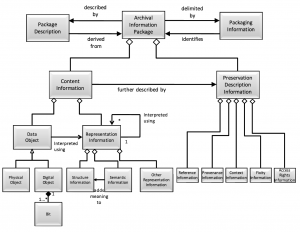![]()
This section is extracted from the deliverable D4.1 Initial version of environment information extraction tools [Corubolo, F. et al (2014)], p.18-21
Please refer to the further reading list for the names referenced to in [ ].
Definition of context
“Context Information: The information that documents the relationships of the Content Information to its environment. This includes why the Content Information was created and how it relates to other Content Information objects.” (from OAIS)
Context is a term with many definitions, a basic dictionary definition being “the circumstances that form the setting for an event, statement, or idea, and in terms of which it can be fully understood [Oxford Dictionary (2013)]”. This clearly relates context to the purpose of understanding information, and this is a key feature of context in relation to digital objects. Context encompasses a broader range of information than metadata; it describes the setting that enables an understanding of a digital object (DO) [Chowdhury, G. (2010)], including for example other DOs, metadata, significant properties, relationships, and policies governing the curation or use of the DO. In [Kari, J. (2007)] context is defined even more broadly as ‘all those things which are not an inherent part of information phenomena, but which nevertheless bear some relation to these’, where the nature of the ‘relation’ is left unspecified.

The OAIS model (figure above – use link for higher resolution) views context as the relationship between a digital object (equivalent to the Content Information in OAIS terms) and its environment. In this view, the environment is considered to be necessary for using the DO, although it does not take into account two factors that we consider essential for our purposes: firstly, the possible variety of different uses to which a DO may be put, which will in general differ in the demands of ‘necessity’ they make on the environment; secondly, the variable strengths of the relationship with different aspects of the environment.
In the TIMBUS project research, context is explored from the point of view of supporting business processes in the long term, describing a meta-model based on enterprise modelling frameworks. The context parameters cover an wide set of parameters, from the legal, business to the system, and technological ones, with the aim of supporting the execution of processes in the long term.
In PERICLES, digital preservation and digital forensics are approached from the angle of preserving content in context, where context can be spatial, temporal, conceptual and/or external, and all of these aspects apply to space and digital art, the domains in study. We note in passing that the dependence of content on context as an insight has been around for quite some time, and this insight returns in the way dependencies play a key role in PERICLES models of content and context.
